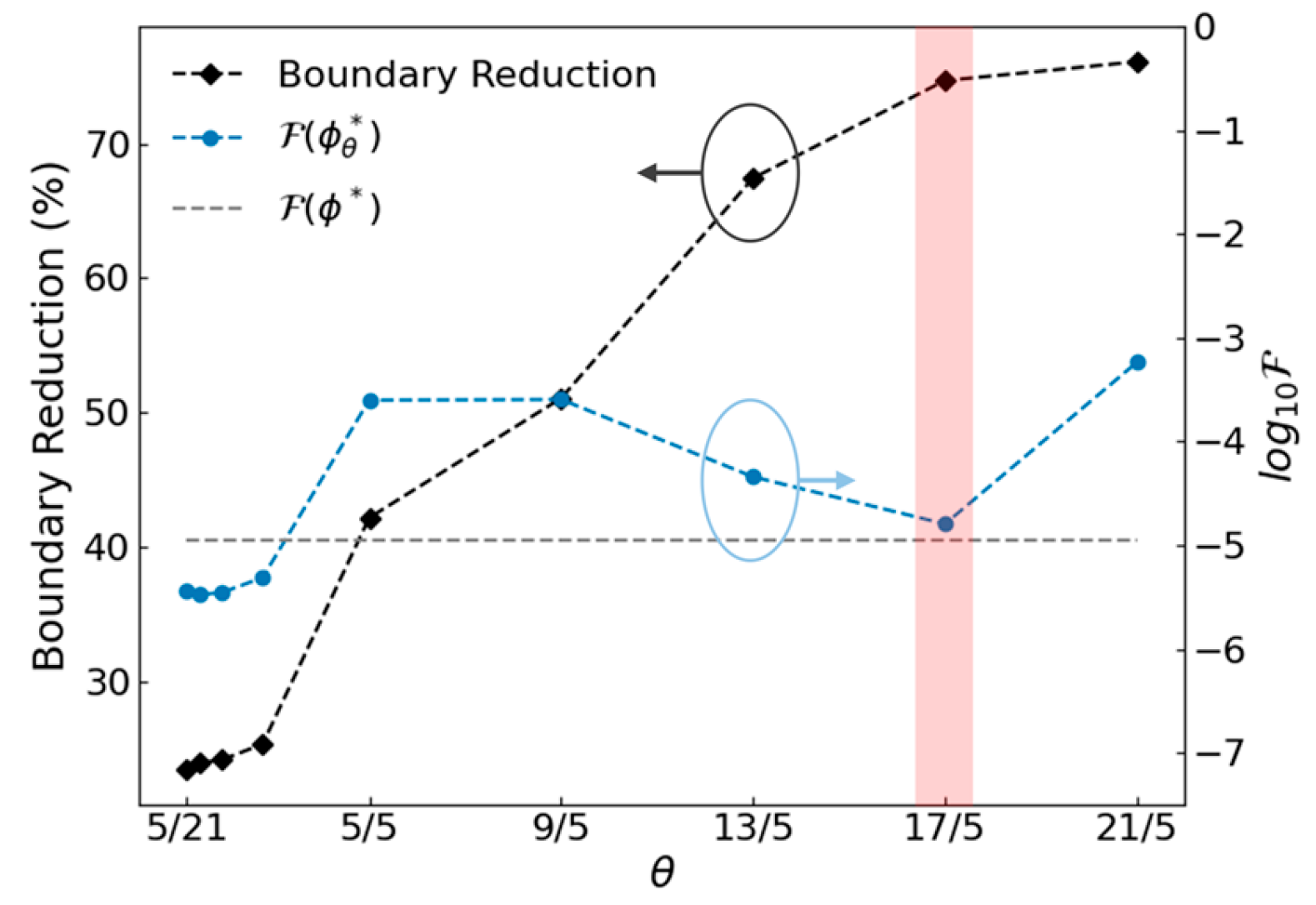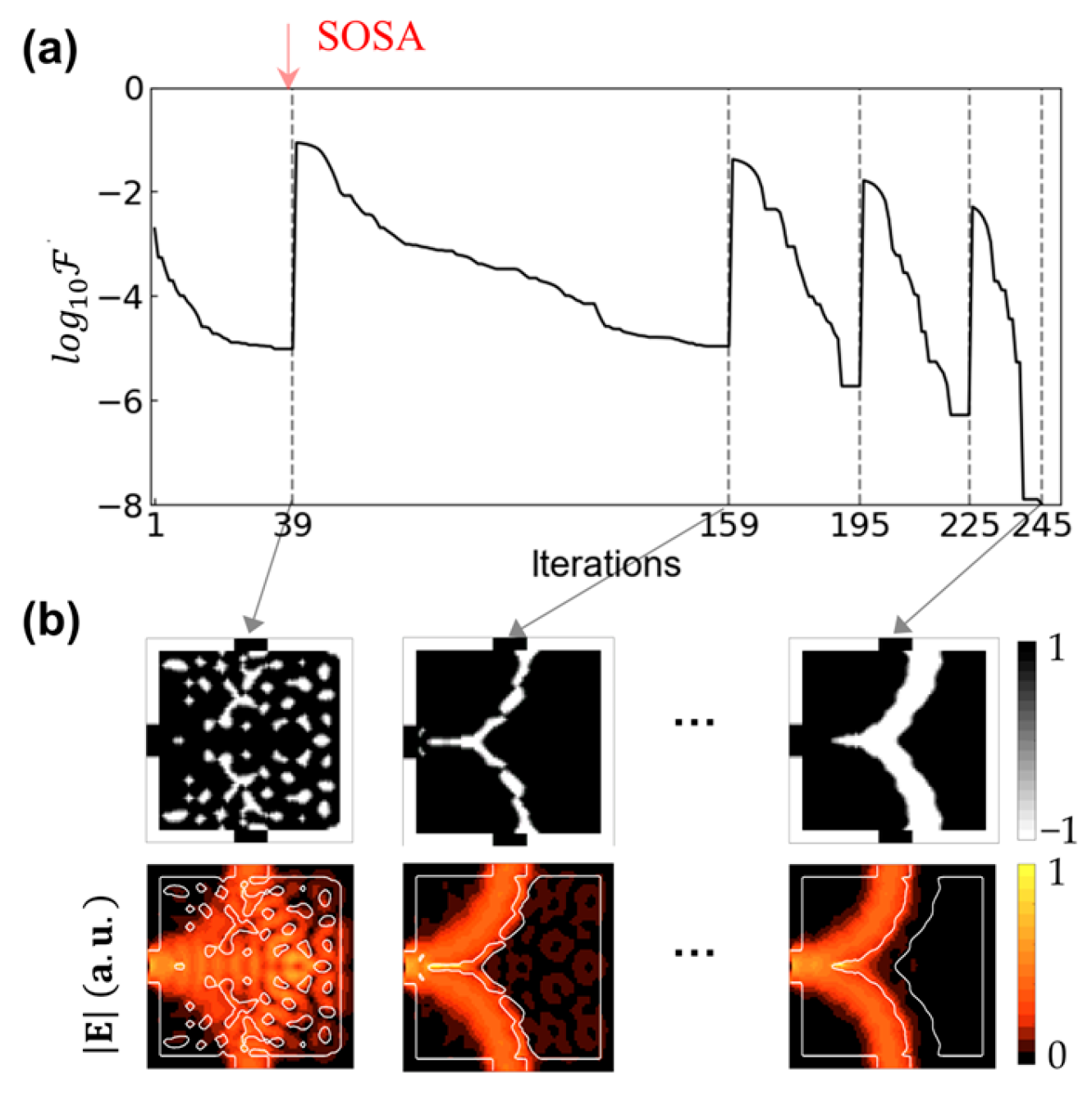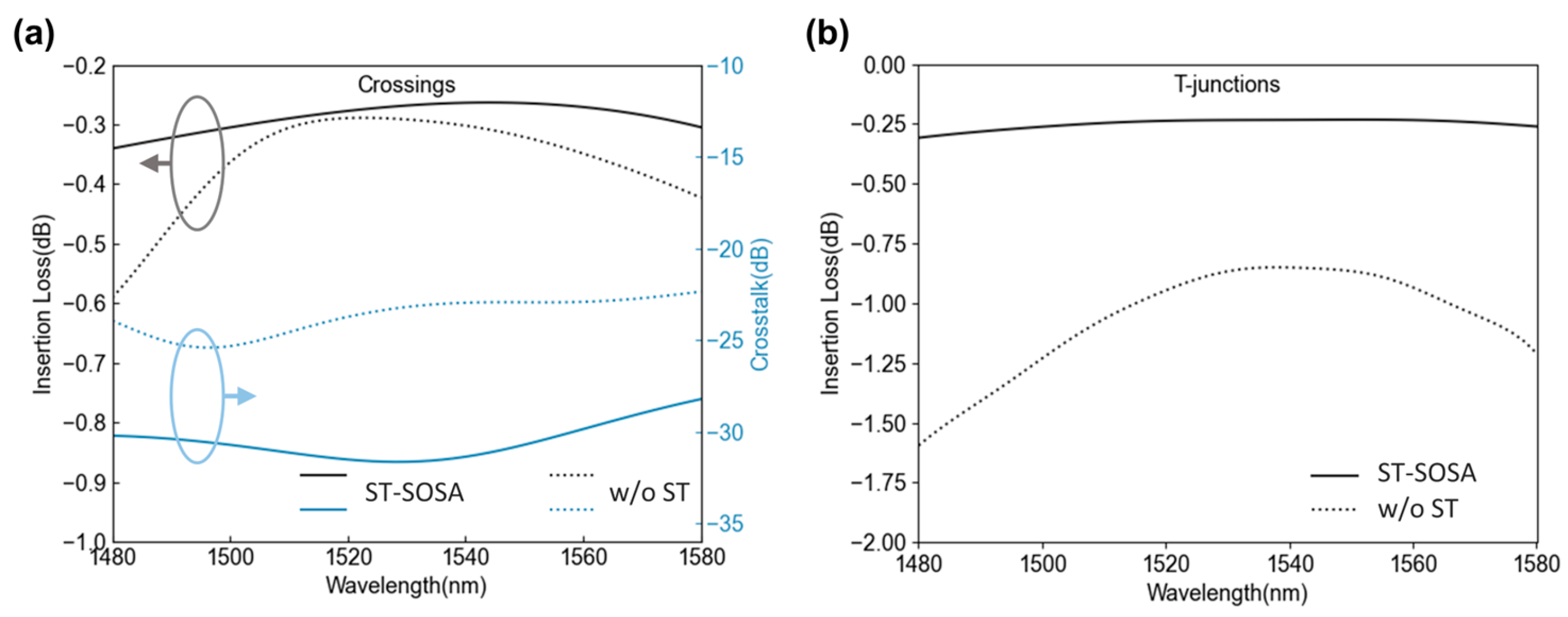Efficient Structure Transformation Based on Sensitivity-Oriented Structure Adjustment for Inverse-Designed Devices
Abstract
1. Introduction
2. Sensitivity-Oriented Structure Adjustment (SOSA)
2.1. Optical Performance Optimization (OPO)
2.2. ACM-DRLSE
2.3. SOSA Based on the Modified ACM-DRLSE
3. Numerical Example
3.1. Design of the 90° Crossing
3.2. Design of the T-Junction
3.3. Broadband Performance Verification and Fabrication Tolerance Simulation
4. Conclusions
Supplementary Materials
Author Contributions
Funding
Institutional Review Board Statement
Informed Consent Statement
Data Availability Statement
Conflicts of Interest
References
- Huang, J.; Ma, H.; Chen, D.; Yuan, H.; Zhang, J.; Li, Z.; Han, J.; Wu, J.; Yang, J. Digital nanophotonics: The highway to the integration of subwavelength-scale photonics Ultra-compact, multi-function nanophotonic design based on computational inverse design. Nanophotonics 2021, 10, 1011–1030. [Google Scholar] [CrossRef]
- Christiansen, R.E.; Sigmund, O. Inverse design in photonics by topology optimization: Tutorial. J. Opt. Soc. Am. B 2021, 38, 496–509. [Google Scholar] [CrossRef]
- Park, J.; Kim, S.; Nam, D.W.; Chung, H.; Park, C.Y.; Jang, M.S. Free-form optimization of nanophotonic devices: From classical methods to deep learning. Nanophotonics 2022, 11, 1809–1845. [Google Scholar] [CrossRef]
- Lazarov, B.; Wang, F.; Sigmund, O. Length scale and manufacturability in density-based topology optimization. Arch. Appl. Mech. 2016, 86, 189–218. [Google Scholar] [CrossRef]
- Hammond, A.M.; Oskooi, A.; Johnson, S.G.; Ralph, S.E. Photonic topology optimization with semiconductor-foundry design-rule constraints. Opt. Express 2021, 29, 23916–23938. [Google Scholar] [CrossRef] [PubMed]
- Guest, J.K.; Prevost, J.H.; Belytschko, T. Achieving minimum length scale in topology optimization using nodal design variables and projection functions. Int. J. Numer. Methods Eng. 2004, 61, 238–254. [Google Scholar] [CrossRef]
- Wang, F.W.; Lazarov, B.S.; Sigmund, O. On projection methods, convergence and robust formulations in topology optimization. Struct. Multidisc. Optim. 2011, 43, 767–784. [Google Scholar] [CrossRef]
- Vercruysse, D.; Sapra, N.V.; Su, L.; Trivedi, R.; Vučković, J. Analytical level set fabrication constraints for inverse design. Sci. Rep. 2019, 9, 8999. [Google Scholar] [CrossRef]
- Khoram, E.; Qian, X.P.; Yuan, M.; Yu, Z.F. Controlling the minimal feature sizes in adjoint optimization of nanophotonic devices using b-spline surfaces. Opt. Express 2020, 28, 7060–7069. [Google Scholar] [CrossRef]
- Chen, M.K.; Jiang, J.Q.; Fan, J.A. Design Space Reparameterization Enforces Hard Geometric Constraints in Inverse-Designed Nanophotonic Devices. ACS Photonics 2020, 7, 3141–3151. [Google Scholar] [CrossRef]
- Melati, D.; Dezfouli, M.K.; Grinberg, Y.; Schmid, J.H.; Cheriton, R.; Janz, S.; Cheben, P.; Xu, D.X. Design of Compact and Efficient Silicon Photonic Micro Antennas With Perfectly Vertical Emission. IEEE J. Sel. Top. Quantum Electron. 2021, 27, 8200110. [Google Scholar] [CrossRef]
- Schubert, M.F.; Cheung, A.K.C.; Williamson, I.A.D.; Spyra, A.; Alexander, D.H. Inverse Design of Photonic Devices with Strict Foundry Fabrication Constraints. ACS Photonics 2022, 9, 2327–2336. [Google Scholar] [CrossRef]
- Dong, Z.; Qiu, J.; Chen, Y.; Wang, L.; Guo, H.; Wu, J. Ultracompact and ultralow-loss S-bends with easy fabrication by numerical optimization. Opt. Lett. 2022, 47, 2434–2437. [Google Scholar] [CrossRef] [PubMed]
- Yu, Z.; Ma, Y.; Sun, X. Photonic welding points for arbitrary on-chip optical interconnects. Nanophotonics 2018, 7, 1679–1686. [Google Scholar] [CrossRef]
- Michaels, A.; Yablonovitch, E. Leveraging continuous material averaging for inverse electromagnetic design. Opt. Express 2018, 26, 31717–31737. [Google Scholar] [CrossRef] [PubMed]
- Yu, Z.; Feng, A.; Xi, X.; Sun, X. Inverse-designed low-loss and wideband polarization-insensitive silicon waveguide crossing. Opt. Lett. 2019, 44, 77–80. [Google Scholar] [CrossRef] [PubMed]
- Chen, Y.; Qiu, J.; Dong, Z.; Wang, L.; Liu, Y.; Guo, H.; Wu, J. Inverse Design of Free-Form Devices With Fabrication-Friendly Topologies Based on Structure Transformation. J. Light. Technol. 2023, 41, 4762–4776. [Google Scholar] [CrossRef]
- Li, C.; Xu, C.; Gui, C.; Fox, M.D. Distance Regularized Level Set Evolution and Its Application to Image Segmentation. IEEE Trans. Image Process. 2010, 19, 3243–3254. [Google Scholar] [CrossRef]
- Piggott, A.Y.; Lu, J.; Lagoudakis, K.G.; Petykiewicz, J.; Babinec, T.M.; Vučković, J. Inverse design and demonstration of a compact and broadband on-chip wavelength demultiplexer. Nat. Photonics 2015, 9, 374–377. [Google Scholar] [CrossRef]
- Piggott, A.Y.; Lu, J.; Babinec, T.M.; Lagoudakis, K.G.; Petykiewicz, J.; Vučković, J. Inverse design and implementation of a wavelength demultiplexing grating coupler. Sci. Rep. 2014, 4, 7210. [Google Scholar] [CrossRef]
- Lu, J. Maxwell-Solver [Source Code]. 2013. Available online: https://github.com/JesseLu/maxwell-solver (accessed on 1 March 2022).
- Chen, Y.; Ge, P.; Wang, G.; Weng, G.; Chen, H. An overview of intelligent image segmentation using active contour models. Intell. Robot. 2023, 3, 23–55. [Google Scholar] [CrossRef]
- Lu, H.; Li, Y.; Wang, Y.; Serikawa, S.; Chen, B.; Chang, C. Active Contours Model for Image Segmentation: A Review. In Proceedings of the 1st International Conference on Industrial Application Engineering 2013, Kitakyushu, Japan, 27–28 March 2013; pp. 104–111. [Google Scholar]
- Caselles, V.; Kimmel, R.; Sapiro, G. Geodesic Active Contours. Int. J. Comput. Vis. 1997, 22, 61–79. [Google Scholar] [CrossRef]
- Sapiro, G. Geometric Partial Differential Equations and Image Analysis; Cambridge University Press: Cambridge, UK, 2006. [Google Scholar]
- Piggott, A.Y.; Petykiewicz, J.; Su, L.; Vučković, J. Fabrication-constrained nanophotonic inverse design. Sci. Rep. 2017, 7, 1786. [Google Scholar] [CrossRef]
- Zhou, M.; Lazarov, B.S.; Wang, F.; Sigmund, O. Minimum length scale in topology optimization by geometric constraints. Comput. Methods Appl. Mech. Eng. 2015, 293, 266–282. [Google Scholar] [CrossRef]












| Devices | T-Junctions | Crossings | ||
|---|---|---|---|---|
| Methods | ST-SOSA | w/o ST | ST-SOSA | w/o ST |
| IL (dB) @ 1530 nm | 0.23 | 0.87 | 0.27 | 0.29 |
| Max IL (dB) | 0.31 | 1.60 | 0.34 | 0.59 |
| MAE of Transmission | 0.013 | 0.185 | 0.017 | 0.049 |
| CT (dB) @ 1530 nm | - | - | −31.65 | −23.20 |
| Max CT (dB) | - | - | −31.65 | −25.42 |
Disclaimer/Publisher’s Note: The statements, opinions and data contained in all publications are solely those of the individual author(s) and contributor(s) and not of MDPI and/or the editor(s). MDPI and/or the editor(s) disclaim responsibility for any injury to people or property resulting from any ideas, methods, instructions or products referred to in the content. |
© 2024 by the authors. Licensee MDPI, Basel, Switzerland. This article is an open access article distributed under the terms and conditions of the Creative Commons Attribution (CC BY) license (https://creativecommons.org/licenses/by/4.0/).
Share and Cite
Chen, Y.; Qiu, J.; Dong, Z.; Wang, L.; Wu, L.; Jiao, S.; Guo, H.; Wu, J. Efficient Structure Transformation Based on Sensitivity-Oriented Structure Adjustment for Inverse-Designed Devices. Photonics 2024, 11, 265. https://doi.org/10.3390/photonics11030265
Chen Y, Qiu J, Dong Z, Wang L, Wu L, Jiao S, Guo H, Wu J. Efficient Structure Transformation Based on Sensitivity-Oriented Structure Adjustment for Inverse-Designed Devices. Photonics. 2024; 11(3):265. https://doi.org/10.3390/photonics11030265
Chicago/Turabian StyleChen, Yuchen, Jifang Qiu, Zhenli Dong, Lihang Wang, Lan Wu, Suping Jiao, Hongxiang Guo, and Jian Wu. 2024. "Efficient Structure Transformation Based on Sensitivity-Oriented Structure Adjustment for Inverse-Designed Devices" Photonics 11, no. 3: 265. https://doi.org/10.3390/photonics11030265
APA StyleChen, Y., Qiu, J., Dong, Z., Wang, L., Wu, L., Jiao, S., Guo, H., & Wu, J. (2024). Efficient Structure Transformation Based on Sensitivity-Oriented Structure Adjustment for Inverse-Designed Devices. Photonics, 11(3), 265. https://doi.org/10.3390/photonics11030265






